
Ingredient
Brussels sprouts and similar-
The Mini Cabbage Marvel
Brussels sprouts are small, compact cabbage-like vegetables that grow in clusters on a stalk. They have a vibrant green color and a distinctive shape, resembling miniature cabbages. Brussels sprouts have a dense texture and a slightly bitter taste, which becomes milder when cooked. They offer a satisfying crunch and can be enjoyed in a variety of dishes.
Origins and history
Brussels sprouts are believed to have originated in ancient Rome and were later cultivated in Belgium, which is how they got their name. They have been a staple in European cuisine for centuries and were introduced to North America by French settlers in the 18th century. Brussels sprouts are now grown in various regions around the world, including the United States, the Netherlands, and China.
Nutritional information
Brussels sprouts are low in calories and rich in essential nutrients. They are an excellent source of vitamin C, vitamin K, and folate. They also provide dietary fiber, which aids in digestion and promotes a healthy gut. Additionally, Brussels sprouts contain antioxidants that help protect against cell damage and inflammation.
Allergens
Brussels sprouts may cause digestive discomfort in some individuals, particularly when consumed in large quantities. They belong to the cruciferous vegetable family, which can be difficult to digest for some people.
How to select
When selecting Brussels sprouts, look for firm, compact heads with vibrant green leaves. Avoid sprouts that have yellowing or wilted leaves, as this may indicate they are past their prime. The size of the sprouts does not necessarily indicate their quality, as both small and large sprouts can be equally delicious. However, smaller sprouts tend to be sweeter and more tender. If possible, choose organic Brussels sprouts to minimize exposure to pesticides.
Storage recommendations
To keep Brussels sprouts fresh, store them in a perforated plastic bag in the refrigerator. This helps maintain their moisture while allowing excess moisture to escape. Brussels sprouts can last up to a week when stored properly. If you have leftover cooked Brussels sprouts, store them in an airtight container in the refrigerator and consume within 2-3 days.
How to produce
Brussels sprouts can be grown in temperate regions with cool summers and mild winters. They thrive in well-drained soil and require full sun or partial shade. Brussels sprouts are typically grown from seedlings, which can be purchased from nurseries or started indoors. They require regular watering and protection from pests, such as aphids or cabbage worms.
Preparation tips
Brussels sprouts can be prepared in various ways. They can be roasted with olive oil and seasonings for a caramelized flavor, sautéed with garlic and lemon for a bright and tangy side dish, or even enjoyed raw in salads when thinly sliced. To enhance their flavor, consider pairing Brussels sprouts with ingredients like bacon, balsamic vinegar, or Parmesan cheese.
Culinary uses
Brussels sprouts are commonly used as a side dish, roasted vegetable, or ingredient in stir-fries. They can also be added to soups, stews, or pasta dishes for added texture and flavor. In European cuisine, Brussels sprouts are often served with bacon or cream-based sauces. They are a popular vegetable during the holiday season and are frequently included in festive meals.
Availability
Brussels sprouts are widely available in North America, Europe, and other regions with a temperate climate. They are commonly cultivated in the United States, the Netherlands, and China.
